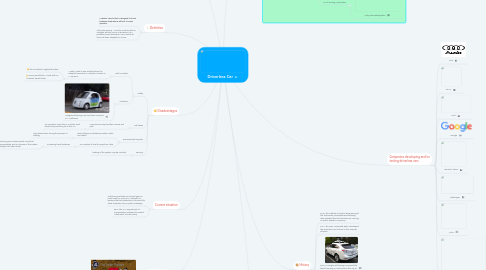
1. Advantages
1.1. Safety
1.1.1. Would eliminate accidents caused by driver error
1.1.1.1. because the sensor will detect the objects near the car
1.2. Welfare
1.2.1. relieve travelers from driving and navigation chores
1.2.1.1. allow drivers to have more time for leisure or work
1.3. Traffic
1.3.1. Can improve traffic flow, dramatically increase highway capacity and reduce or eliminate traffic jams
1.4. Costs
1.4.1. safer driving may lead to the reduction of the costs of vehicle insurance
2. Disadvantages
2.1. Safety
2.1.1. Fatal Accident
2.1.1.1. A Tesla Model S was involved when the autopilot was active in Williston, Florida on 7 May 2016
2.1.1.1.1. the car failed to apply the brakes
2.1.1.1.2. Driver was killed in a crash with an 18-wheel tractor-trailer
2.1.2. Collisions
2.1.2.1. Google self-driving cars have been involved in 14 collisions
2.2. Job losses
2.2.1. many drivers may loss their income and jobs
2.2.1.1. For example: more than 3.5 million truck drivers may loss their job in the U.S.
2.3. Environmental Impacts
2.3.1. Tesla's lithium-ion batteries contain nickel and cobalt
2.3.1.1. may release toxic during the process of refining
2.3.2. an incentive to live far away from cities
2.3.2.1. increasing travel distances
2.3.2.1.1. inducing more urban sprawl, more fuel consumption and an increase in the carbon footprint of urban travel
2.4. Secruity
2.4.1. hacking of the system may be involved
3. Definition
3.1. a robotic vehicle that is designed to travel between destinations without a human operator.
3.2. Fully autonomous : a vehicle must be able to navigate without human intervention to a predetermined destination over roads that have not been adapted for its use.
4. Current situation
4.1. Self-driving vehicles are not yet legal on most roads. In June 2011, Nevada, US became the first jurisdiction in the world to allow driverless cars on public roadways.
4.2. 2016: the U.S. Department of Transportation released its Federal Automated Vehicles Policy
5. Technology
5.1. SLAM
5.2. DATMO
5.3. RTLS
5.4. Senors involved
5.4.1. Lidar
5.4.2. Stereo vision
5.4.3. GPS
5.4.3.1. locate positional information
5.4.4. IMU
5.4.4.1. localize itself & refine its position estimate as well as to build a three-dimensional image of its environment
6. Moral issues
6.1. The Trolley Problem
6.1.1. Can the driverless system help the driver to face the moral dilemma when accidents happen?
7. Classification
7.1. Levels of driving automation
7.1.1. 0: No Driving Automation
7.1.1.1. Fully manual system
7.1.2. 1: Driver Assistance
7.1.3. 2: Partial Driving Automation
7.1.4. 3: Conditional Driving Automation
7.1.5. 4: High Driving Automation
7.1.6. 5: Full Driving Automation
7.1.6.1. Fully automated system

